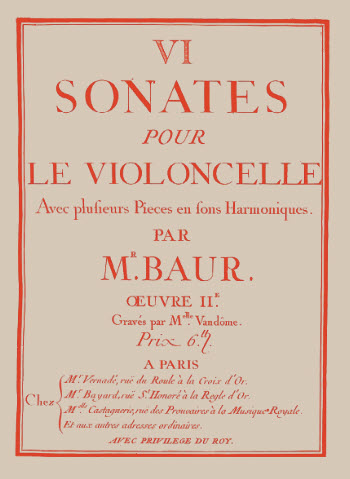by Pierre Ruhe
Published January 1, 2024
Jean Baur: Chamber Music. Cellist Elinor Frey and Accademia de’ Dissonanti. Passacaille Records, PAS 1123

This sparkling new recording introduces what, for almost everyone, will be unknown music by an unknown composer. Born in the province of Lorraine, near the German border, Jean Baur (1719-c.1773) is credited as the first French composer and performer on the pedal harp and, owing to this new technology, perhaps the first whose published music distinguishes between the harp and keyboard. Along with his children and grandchildren, he created something of a harp dynasty: they performed, published, taught, and helped popularize technical advancements for the instrument. At the same time, just as Baur settled in Paris around 1745, the cello was in high vogue. His chamber music, remarkably joyful and tuneful, covers all these instrumental combinations.

Add Baur to the growing discography of Seattle-born, Montréal-based cellist Elinor Frey. The performer-scholar and her Accademia de’ Dissonanti dip into a range of Baur’s chamber music originally intended for the home and the salon, where flexible instrumentation in the score meant that his sonatas and duos could (mostly) adapt to the variety of instruments that were on hand.
Frey’s playing in the recording’s opening G minor Cello Sonata (Op. 1, No. 4), from 1751, sets the mood. After a brief, somber Adagio introduction, the Allegro bursts out with an exuberant tune, flowing and free. Frey’s tone is at once bright, warm, and focused, and she delivers with the verve and personality of a soloist. Elsewhere, in an accompanying role, she blends with the ensemble – evidence of a solid chamber musician.
They are at home in Baur’s galant style, where rhythmic sprightliness, simplicity of texture, and a seemingly effortless lyricism make the music an easy pleasure – at least for the listener. Yet we know little of the composer’s musical background. His more formal earlier pieces, like the three cello sonatas presented here (all from the 1750s), and the more decorative works from later in his career, suggest growth and adaptation to the trends of the day. Throughout, his voice is strong and the stylistic differences are small. His first published works were for cello. As a harpist, he performed at the Concert Spirituel in Paris, although his writing for both harp and cello is idiomatic enough to suggest he was a serious performer on both. But which came first? Intriguingly, Frey’s liner notes mention that the cello part’s double stops and arpeggios correspond to “the intuitions of a harp player.”

Frey’s virtuosity and panache is matched by the ensemble. Cellist Octavie Dostaler-Lalonde is part of the continuo band but joins Frey as soloist in Baur’s Sonata No. 1 in F for Two Violins (published 1774), arranged here for two small cellos or violoncello piccolo – tuned an octave below a violin and roughly the size of today’s 3/4-size cello. Then as now, the sonata’s bouncy tunes and buoyant spirit would be a special treat for skilled amateurs.
Antoine Malette-Chénier, as continuo, plays a single-action pedal harp built by Jean-Henry Naderman, c. 1790, in Paris. He’s unaccompanied for the Sonata for Harp No. 6 in C, music that’s at turns subtle, forceful, and always full of character. Malette-Chénier is joined by Mélisande McNabney on the fortepiano for the Sonata for Harp and Fortepiano, Op. 8, No. 3, a true duo where the instruments alternate between foreground and background.

An added layer of interest in Baur’s music is that the engraver of his cello sonatas was Marie-Charlotte Vandôme. She and her sister were among the most skilled of the era, engraving music from Scarlatti and Boccherini to the very young Mozart. Frey and her colleagues found this notable enough that their CD cover (top image) is an engraving of a woman’s hand holding an engraving tool; the booklet (lower image) shows the title page of Baur’s Sonates pour le violoncelle that credits “Gravés par Melle Vandôme,” along with the price and the Parisian shops where musicians could buy it.
Frey credits her aunt, Barbara Thornton, a medieval-music specialist with an EMA award honoring her legacy, as an early influence on her listening, music-making, and sense of exploration. With the chamber music of Jean Baur, a remarkable find, we have an invaluable collection for the listener and for the musician looking to expand their own repertoire.
Pierre Ruhe is publications director of Early Music America.




